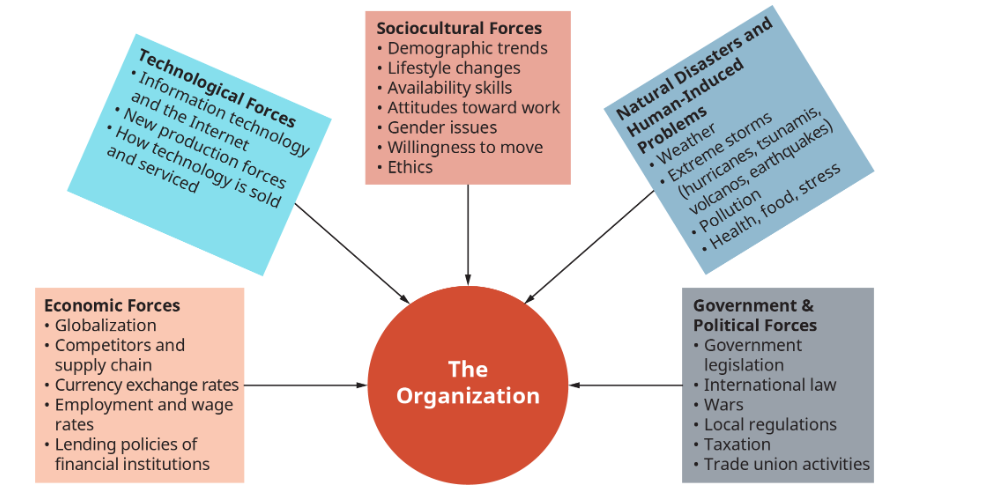7.3 External Organization Environment
When making sense of the external environment, it is important that all organizations are formed to achieve organizational goals. To achieve these, most look outside of their own walls to what is called the external environment. The external environment, or general environment, involves outside factors which impact the operation of the organization, in turn, causing the organization to respond and react in order to maintain its momentum[11]. Figure 1 shows some of the external environments that are present within organizations, and how they adjust in external environments.

The impact on the global market can determine a modern organization’s place in the world. Economic forces are those that pertain to a company’s role within its national or global economy. Overall, the impact of globalization, in general, has rendered positive effects. However, rates of household economy in 25 advanced-economy countries have dropped or remained stagnated at a rate of two-thirds[11]. There are two defining trends that have an adverse effect on the economy and are key characteristics in the external organization environment.
|
Technological Forces |
Government and Political Forces |
|---|---|
| · If an organization can effectively enhance its usage of technology, this can render a substantial competitive advantage[11]. | · In a modern economy, foreign policy and diplomacy have a big effect on how organizations operate in a global marketplace. |
Outside the economy, organizational impact can have an effect on the people, not only on the inside of the organization, but also on the outside. Socio-cultural forces include the values, beliefs, customs and traditions of different people with regard to race, religion, gender and other socio-cultural backgrounds[11]. Within educational establishments, there are social-cultural forces that have rendered quite an impact, given the diversity of these institutions in recent years. Be it age, religion, race, gender or sexuality, leaders within learning organizations will have to be cognizant of the socio-cultural forces that effect and are identified within them.
Climate change is also an influence. Natural disasters and human induced-problems are issues that relate to our natural environment, including high-impact storms and the rise of CO2 emissions[11]. The public has become more cognizant, as of late, about the effects of climate change, and are aware of the effect that humans have caused to the rapid temperature change. As leaders, it is important to be interdisciplinary in these areas so that a wealth of knowledge can be presented to fellow learners and colleagues.
When developing a sense of motivation within a socio-cultural environment, We can refer back to Maslow’s hierarchy and the Herzberg two-factor theory of motivation to develop an understanding in a modern learning environment. Kiel suggests a level of lifelong learning with regard to the Maslow hierarchy, insinuating that self-actualizing is continually evolving especially in the educational landscape[12]. This is prevalent in a 21st century classroom considering the different learners, and needs tailored to different learners within the classroom: this ultimately opens the door to continual self-actualization for a leader. As for the Herzberg two-factor theory of motivation, Hur studied the effect of the theory on public employees and concluded the Herzberg theory to have a positive effect on employees, however, implications showed differing motivational factors from public employees (i.e. schools), compared to private sector employees (i.e. for-profit corporation), such as in the area of advancement, training, and career development[13]. In another framework, Gordon Rouse concludes that the Maslow hierarchy is not a hierarchy at all, rather that multiple steps can be completed at one time, through searching for happiness and transcendence in their managerial or leadership roles[14]. This creates an interdisciplinary framework to understanding the technical and emotional aspects of the organizational environment through internal and external factors.
Relating public vs. private employees relationship to motivation, we must look at the organizational ‘fit’ one has within an organization. Katzel and Thompson conclude that leaders need to ensure workers values are aligned with the goals and mission of the organization, in addition, offering goals that are clear, attractive and attainable[15]. Wadsworth and Facer suggests that an enhanced focus on a work-life balance will have a positive effect on employees motivation to do the job[16]. Motivation, job-design, and the relation to the real-world environment are all intertwined in an organizational framework, especially within a learning organization, which strives to learn about the complexity of these intertwining factors.
Review Questions:
- What are the five macro forces of organizational environments? What are their characteristics?
- What are the impacts of socio-cultural forces within organizations?
- What interdisciplinary practices can be used in the organizational environment?
forces that pertain to an organizations role within its national or global economy
Forces pertaining to the values, beliefs, customs and traditions of different people in regards to race, religion, gender and other socio-cultural backgrounds

